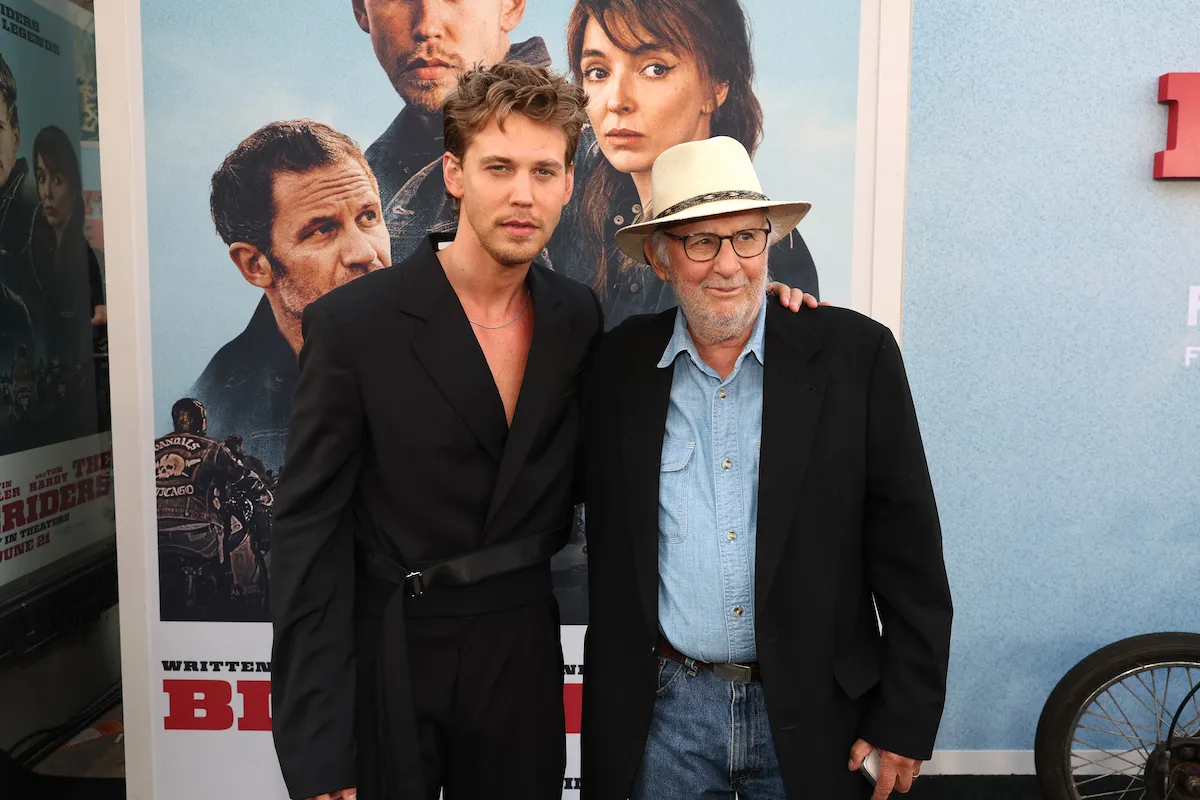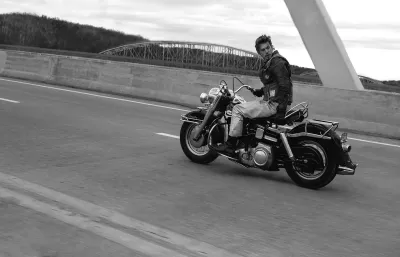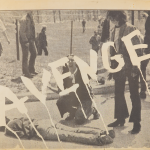
Danny Lyon’s 1966 photograph Crossing the Ohio River, near Louisville is regarded as a classic for a reason. In it, a man is seen riding a motorcycle across a bridge, looking not forward at the road, as one would hope, but backward toward sights unseen. The velocity of his vehicle whips his hair back; the pavement beneath becomes a blur as Lyon’s camera races to keep up.
Everything about the picture feels daring and exciting, a sentiment made all the more clear by the biker’s leather jacket emblazoned with the word OUTLAWS. But around this man is the bridge he’s crossing and one other, and little more. He is alienated, set apart from the rest of the world by his own making. No one is there to witness his stunt.
That photograph appeared in Lyon’s legendary 1968 photobook The Bikeriders, and it has now been restaged for the screen, this time with actor Austin Butler, as part of a film that shares the book’s title. The film adaptation also follows a biker gang in the Midwest, and some of the people whom Lyon photographed even appear as characters. Though fictionalized, Jeff Nichols’s film remains true to Lyon’s vision, exploring self-imposed outsiderdom and tortured masculinity in the same way.
The subject of a Whitney Museum retrospective in 2016, Lyon himself makes an appearance at various points, played here by Mike Faist, who has recently gained wide acclaim for his roles in the 2021 remake of West Side Story and this year’s Challengers. In the film, Lyon is periodically shown at work, photographing members of the Vandals gang while they throw back beers and ride together. (The actual gang featured in Lyon’s photobook was called the Outlaws, whose membership eventually counted the photographer himself; Nichols has said that he changed the name because he wanted his version to be a clearly fictionalized account.)
But much of the time when Lyon is on screen, he is shown interviewing Kathy Bauer (Jodie Comer, playing an actual person from Lyon’s book), who muses on her marriage to Benny (Butler) and the strain that his ties to the Vandals has placed on it. Comer does much of the talking while Lyon listens, patiently recording her words over the course of nearly a decade.
That’s what Nichols’s film gets so right about Lyon’s process: he has prioritized long-term engagement with his subjects, unlike most documentary photographers, who traditionally have captured discrete moments and not gotten close to the people they portray. Faist, who performs Lyon as a warm, debonair force of good in a rough crowd, smartly does not play up his presence too much. Neither does Nichols’s screenplay, which makes Lyon a secondary character.

The focus, mostly, is the cast of oddballs around Lyon, performed here by actors including Tom Hardy, Michael Shannon, Karl Glusman, and Norman Reedus. Yet it is Kathy who gets the most attention from Nichols, and that’s the biggest difference from Lyon’s photobook. Even though Lyon spent significant time with her, interviewing her extensively, she shows up in only one shot, posed before a mirror sporting a beehive hairdo. But Kathy is arguably the main character in Nichols’s Bikeriders, since she narrates everything that’s happening.
This is a film that honors Lyon’s photography, which is about more than just the pictures themselves. The pictures are also the product of many conversations with the people in them, and the movie is appropriately character-driven in that way. Nichols himself said as much to the Globe and Mail: “If I’m being completely honest, I’m not really interested in contemporary biker culture. I was interested in the people in Danny’s book.”
